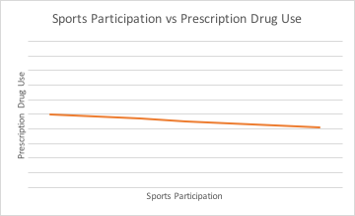Is Sports Participation Associated With Illicit Prescription Drug Use?
Sidney Carscallen, Lauren Williams, Jeremy Knapp, Justin Hauge, Dr. Megan Smith

Introduction
Teen prescription drug abuse of medications such as OxyContin, Percocet, and Vicodin is on the rise in the US and, according to SAMHSA, is becoming a major adolescent health issue. Misuse of prescription drugs can have life-threatening consequences such as death from overdose, depressed respiration, and addiction. While there are many factors as to why adolescent drug abuse is rising, we will observe the correlation with prescription drug abuse and high school athletes. It is common for doctors to prescribe highly addictive drugs to injured athletes and it puts them at high risk for prolonged abuse. Existing solutions to the issue include other programs and clubs that do not provide a risk of injury. Limitations to this solution would be the lack of access to these opportunities. School sports tend to be more accessible due to the activity being on campus and typically right after school. Athletics have the ability to build character and keep students driven in school in order to continue playing. However; the importance of our research is to highlight the risks of involvement in high impact/injury prone athletics. Through the research process, we have observed the correlations to determine if high school athletics puts students at risk for prescription drug abuse or serves as a protective factor and deters students from abusing drugs.
Methods
This study used a secondary data analysis approach with cross-sectional data to examine connections between sports participation and illicit prescription drug use.
Participants
Data collected were from a survey of middle school and high school students (grades 5-12) in 15 public schools in 3 different counties from a mid-Atlantic state. 13,736 students responded to the survey with the middle school response rate being 84.2%, and the high school response rate being 74.0%. 49.5% of participants self-identified as male, 48.7% of participants self-identified as female, and 1.8% of participants self-identified as other.
Procedures
Data were collected during the school day with present students using a paper-and-pencil and/or on-line format, based on school preference. Surveys were completed in a two-week window. Teachers assisted a county study coordinator to administer the survey. The IRB at a major research university approved the study.
Measures
One variable that we were focused on was the participation in sports. Participants were asked, “How many times a week do you participate in any of the following out-of-school activities that are supervised by adults?”. They were then provided with options ranging from ‘Never or almost never’ to ‘Seven times per week’.
Another variable that we looked into was the illicit use of prescription drugs by being asked: “How many times have you used the following drugs or substances in your life?”. Participants were provided with a list of drugs and answers ranging from ‘0 times’ to ‘40 or more times’. One of the drug options was prescription drugs such as OxyContin, Percocet, Vicodin, Codeine, Adderall, Ritalin, or Xanax without a doctor’s prescription.
Data Analysis Approach
A bivariate correlational analysis was run to assess the potential association between sports participation and prescription drug use.
Results
How does sports involvement influence prescription drug use in high school students? Using an alpha of 0.05 we found a significant association between prescription drug use and high school sports. Participation in high school sports and prescription drug use were weakly negatively associated, r = -0.03. This means that high school students participating in sports participate in prescription drug use less often.

Discussion
With this research, we have found that sports participation may be protective for illicit drug use. We believe that this is the case because students involved in after school sports programs may not be in an environment where the use of prescription drugs without a doctor’s prescription is prevalent, since they are spending more time with potential role models or coaches.
Limitations
There were some limitations in our study, including the fact that we did not have a way to know if these students had a previous condition where they were originally prescribed these painkillers. Another limitation was that we did not specify which sport the student was participating in.
Future Directions
In the future research in this area, we would like to see if there are other factors that could protect from the illicit use of prescription drugs. Some other variables that could be researched are previous doctor prescriptions for painkillers, underlying conditions such as depression, or family history of illegal use of prescription drugs. Another question that could be asked is what sport has the highest risk of illicit use of prescription drugs.
These results show that involvement in after school sports programs may help teens and adolescents to stay away from the use of prescription drugs without a doctor’s prescription. This research is important because it shows that it could be beneficial to make sports available at all schools for all students in order to provide them with an after school activity, especially in at risk populations.